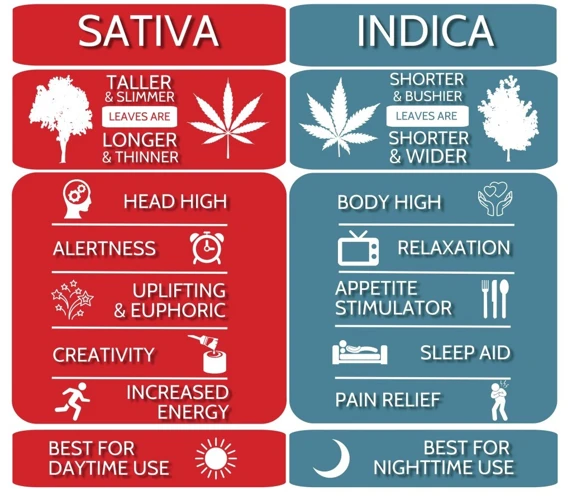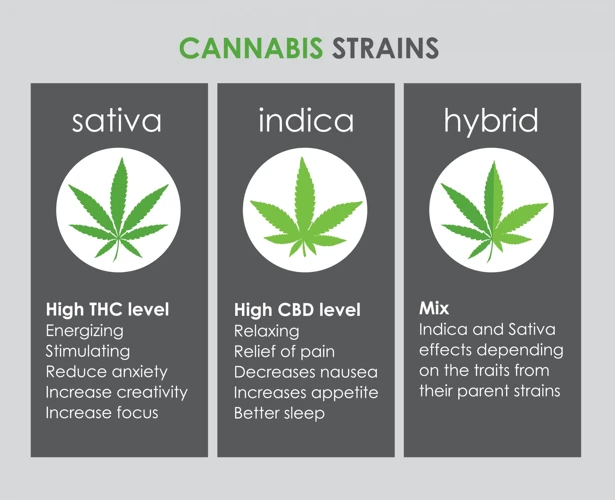
Indica vs Sativa for Medical Use
As the world of medical marijuana continues to grow and evolve, the choice between indica and sativa strains can be a perplexing one. Many patients find themselves wondering how to choose the right strain for their medical needs. With so many different strains and product options available on the market, it can be overwhelming to figure out where to start. However, with a little education and guidance, patients can select the perfect strain to meet their unique medical requirements. In this article, we’ll explore the differences between indica and sativa strains, discuss how to choose between the two, dive into the popular strains available, and explore the many benefits and side-effects that each type can offer.
What are Indica and Sativa Strains?
Contents
When it comes to medical marijuana, two terms that you may have heard are Indica and Sativa. Understanding the differences between these two types of strains is crucial in choosing the right one for your needs. While both types of strains come from the same Cannabis Sativa plant family, they have different properties that affect how they can be used medicinally. Let’s dive deeper into Indica and Sativa strains and explore their unique characteristics that set them apart. To learn more about how these two strains compare, check out our Indica vs Sativa Strains guide.
Indica
Indica strains of cannabis are known for their relaxing and sedative effects on the body. These strains are typically used in the evening or before bed to help users unwind and get a good night’s sleep. Indica strains can also provide relief from chronic pain, muscle spasms, and anxiety.
Physical Characteristics
Indica plants are typically shorter and bushier than Sativa plants, with wider leaves and denser buds. The buds of Indica strains are often dark green, purple, or blue in color, and are covered in sticky trichomes.
Effects
The effects of Indica strains are commonly described as a “body high”, which can be felt throughout the entire body. Users may experience feelings of relaxation, drowsiness, and a general sense of calmness. Indica strains are also known for their ability to alleviate pain and muscle tension.
Cannabinoid Profile
Indica strains tend to have a higher percentage of CBD (cannabidiol), which is a non-psychoactive compound that can provide pain relief and reduce inflammation. They also typically have a lower THC (tetrahydrocannabinol) content, which is the compound responsible for the “high” feeling associated with cannabis use.
Terpene Profile
Indica strains are known for their terpene profile, which can include myrcene, linalool, and beta-caryophyllene. These terpenes are believed to contribute to the relaxing effects of Indica strains.
Popular Indica Strains
Some of the most popular Indica strains for medical use include:
- Granddaddy Purple
- Bubba Kush
- Northern Lights
- Blueberry
- Blackberry Kush
It is important to note that the effects of Indica strains can vary depending on the individual and the specific strain being used. It is always important to consult with a medical professional before using cannabis for medical purposes.
Sativa
Sativa strains are known for their uplifting and energizing effects on the mind and body. They are often recommended for daytime use, as they tend to provide a boost of energy and mental clarity. Sativa strains typically have a higher THC (tetrahydrocannabinol) to CBD (cannabidiol) ratio, which means they are more psychoactive and less suited for those seeking pain relief or other medical benefits.
The table below highlights some common characteristics of sativa strains:
| Physical Appearance | Tall and thin plants with narrow leaves |
| Flavor and Aroma | Spicy, sweet, or fruity with a citrusy aroma |
| Effects | Uplifting, energizing, and cerebral with a boost in creativity, focus, and sociability |
| Common Medical Uses | Depression, anxiety, ADD/ADHD, fatigue, and nausea |
| THC to CBD Ratio | Higher THC to CBD ratio, typically ranging from 3:1 to 20:1 |
It’s important to note that while sativa strains are often associated with an energy boost, some individuals may actually find them to be anxiety-inducing or stimulating to the point of jitters. Like with any strain, it’s best to start with a low dosage and monitor your reactions.
Additionally, while sativa strains may not be as effective for certain medical conditions, they have been known to provide relief for others, such as depression and anxiety. It’s always best to consult with a medical professional to determine the best strain for your individual needs.
How to Choose Between Indica and Sativa Strains for Medical Use
When it comes to using cannabis for medical purposes, it’s important to choose the right strain that best suits your needs. With so many options available, it can be overwhelming to decide between indica and sativa strains. However, by considering your individual needs and understanding the effects, cannabinoid and terpene profiles, and consulting with a medical professional, you can make an informed decision. In this section, we will explore how to choose between indica and sativa strains for medical use, and help you find what works best for you.
Determine Your Needs
When it comes to choosing between indica and sativa strains for medical use, the first step is to determine your needs. Consider the following factors to help guide your decision:
- Symptoms: Identify the symptoms you would like to treat with medical cannabis. For example, if you are seeking relief from pain, anxiety, or insomnia, an indica-dominant strain may be more suitable for your needs.
- Time of day: Think about when you plan to consume cannabis. If you are looking for a strain to help you relax and unwind in the evening, an indica-dominant strain may be a better option than a sativa. If you need to stay alert and focused during the day, a sativa-dominant strain may be more appropriate.
- Personal preference: Consider your individual preferences and tolerance levels. Some people may find that indica strains make them feel too sedated or “couch-locked,” while others may prefer the calming effects of indicas. Similarly, some people may find that sativas cause anxiety or over-stimulation, while others may prefer the energizing effects of sativas.
It is important to determine your needs and preferences in order to choose the right strain for your medical use. By taking into consideration factors such as your symptoms, time of day, and personal preferences, you can make an informed decision and select a strain that will help you manage your medical conditions effectively without unwanted side effects. If you are uncertain about which strain to choose, it is always best to consult with a medical professional or a qualified cannabis specialist who can provide you with personalized recommendations based on your specific needs and medical history.
Consider the Effects of the Strains
When considering the effects of the strains, it’s important to understand what each strain can offer. Here are some key points to consider:
- Indica: Indica strains are known for their sedative and relaxing effects. They often provide a physical and calming effect on the body. This makes them an ideal choice for those looking for help with sleep or relaxation. They can also be effective for managing chronic pain and muscle spasms.
- Sativa: Sativa strains are known for their energizing and uplifting effects. They often provide a mental and cerebral effect on the brain. This makes them an ideal choice for those looking for help with focus or creativity. They can also be effective for managing depression and mood disorders.
It’s important to note that the effects of each strain can vary depending on the individual and the dosage. Some strains may be more potent than others, which means they may have a stronger effect. It’s essential to start with a low dosage and work your way up to find the strain that works best for you. Additionally, it’s crucial to choose a strain that fits your specific needs and desired effects.
Understand the Cannabinoid and Terpene Profiles
When choosing between indica and sativa strains for medical use, it’s essential to understand the cannabinoid and terpene profiles. Here are some key points to keep in mind:
- Cannabinoids: These are the compounds that interact with the body’s endocannabinoid system, producing various effects. THC is the most well-known cannabinoid, as it’s responsible for the “high” associated with cannabis use. However, CBD is another important cannabinoid, as it provides numerous potential medical benefits without the psychoactive effects of THC. Other cannabinoids to be aware of include CBG, CBN, and THCV.
- Terpenes: These are the aromatic compounds found in cannabis and many other plants. They’re responsible for the distinctive smells and flavors of different strains. However, they also play a role in the effects of each strain. For example, some terpenes may have anti-inflammatory or anti-anxiety properties.
- Entourage effect: This term refers to the idea that the various cannabinoids and terpenes in a strain work together to produce a synergistic effect. In other words, a strain with a diverse cannabinoid and terpene profile may be more effective than one with high levels of just one or two compounds.
- Lab testing: Look for strains that have been tested by a third-party laboratory. These tests can provide detailed information about the cannabinoid and terpene profiles of each strain, as well as the presence of any contaminants.
Understanding the cannabinoid and terpene profiles of each strain can help you choose one that will provide the specific medical benefits you’re looking for. Don’t be afraid to ask your dispensary or medical professional for more information.
Consult with a Medical Professional
When it comes to using cannabis for medical purposes, consulting with a medical professional is crucial. Medical professionals can provide valuable insight and guidance for patients looking to use cannabis to manage their symptoms.
During a medical cannabis consultation, a healthcare provider can help determine the best strain and consumption method based on a patient’s medical history, current symptoms, and any medications they may be taking. They can also provide important information about possible drug interactions and potential side effects.
Here is a table summarizing the benefits of consulting with a medical professional when using cannabis for medical purposes:
| Benefits | Explanation |
|---|---|
| Personalized Treatment | A medical professional can help determine the best strain and consumption method for a patient’s specific medical needs |
| Professional Guidance | Healthcare providers can provide important information about possible drug interactions and potential side effects |
| Legal Protection | If medical cannabis is not legally available in a patient’s state or country, a healthcare provider can help provide documentation and support for obtaining it |
| Improved Safety | Consulting with a medical professional can help reduce the risk of adverse effects or complications from using cannabis for medical purposes |
It is important for patients to be honest and open with their healthcare provider about their cannabis use, and to ask any questions they may have about using cannabis for medical purposes. With the guidance and support of a medical professional, patients can safely and effectively use cannabis to manage their symptoms and improve their quality of life.
Popular Indica and Sativa Strains for Medical Use
As the demand for medical marijuana continues to rise, the popularity of both Indica and Sativa strains has increased significantly. Each strain offers unique benefits and effects that cater to different medical needs. In this section, we will highlight some of the most popular and effective Indica and Sativa strains for medicinal use. Whether you’re seeking relief from chronic pain, anxiety, or nausea, there’s a strain that’s just right for you. Keep reading to discover which strain may suit your medical needs.
Indica Strains
Indica strains are known for their relaxing and sedative effects on the body. These strains are generally recommended for nighttime use, as they can induce sleep and help with insomnia. Some of the most popular indica strains for medical use include:
- Granddaddy Purple: This strain is known for its grape and berry aroma, and it can help with pain, stress, and insomnia.
- Bubba Kush: Bubba Kush is a powerful strain that can help with pain, stress, and insomnia. It has a sweet and earthy aroma.
- Northern Lights: This strain has a sweet and spicy aroma, and it can help with pain, stress, and insomnia. Northern Lights is also known for its ability to improve mood.
- Blueberry: As its name suggests, Blueberry has a sweet and fruity aroma. It can help with pain, stress, and insomnia, and it is also known for its ability to stimulate appetite.
- Purple Kush: This strain has a sweet and earthy aroma, and it can help with pain, stress, and insomnia. Purple Kush is also known for its ability to induce relaxation.
It is important to note that everyone reacts differently to different strains, so it is important to experiment with different types of indica strains to find the one that works best for you. Some common side effects of indica strains include dry mouth, dry eyes, and dizziness. It is important to consult with a medical professional before using any new strain for medical purposes.
Sativa Strains
When it comes to medicinal use, Sativa strains are often preferred for their uplifting and energizing effects. These strains are known for their higher levels of THC, which can provide a euphoric and cerebral experience. Sativa strains are typically recommended for daytime use as they tend to increase, rather than decrease, productivity and creativity. In the table below, we discuss some of the most popular Sativa strains for medical use.
| Strain | Cannabinoid Profile (THC:CBD) | Terpene Profile | Medical Uses |
|---|---|---|---|
| Green Crack | 22:1 | Limonene, Myrcene, Caryophyllene | Depression, Anxiety, Fatigue |
| Jack Herer | 17:6 | Pinene, Myrcene, Caryophyllene | Depression, Stress, Pain, Fatigue |
| Sour Diesel | 19:1 | Terpinolene, Myrcene, Caryophyllene | Depression, Anxiety, Pain, Fatigue |
| Super Silver Haze | 16:1 | Limonene, Myrcene, Caryophyllene | Depression, Fatigue, Pain, Stress |
| Tangie | 14:1 | Myrcene, Pinene, Limonene | Depression, Anxiety, Fatigue, Stress |
As with any strain, it is important to research and select a Sativa strain that fits your specific needs and medical condition. It is also important to start with a small dosage and gradually increase as needed to avoid any negative side effects such as anxiety or paranoia.
How to Consume Indica and Sativa Strains for Medical Use
Finding the right consumption method is a crucial aspect of using cannabis for medical purposes. There are several ways to consume indica and sativa strains, and each method has its own set of benefits and drawbacks. Whether you prefer smoking, vaping, edibles, topicals, or tinctures, there is a suitable consumption method for you. In this section, we’ll explore the different options available and help you decide which one is best for your needs.
Smoking and Vaping
When it comes to consuming indica and sativa strains for medical use, one of the most popular methods is through smoking and vaping. Both methods involve inhaling the smoke or vapor produced by the cannabis plant. However, there are some key differences between smoking and vaping that are worth considering.
Smoking:
- Smoking involves combusting the cannabis plant using a flame.
- The smoke produced by smoking can be harsh and irritating to the throat and lungs.
- The effects of smoking cannabis are felt almost immediately.
- Smoking is a quick and convenient way to consume cannabis.
Vaping:
- Vaping involves heating the cannabis plant to a temperature that vaporizes the active compounds without burning the plant material.
- The vapor produced by vaping is smoother and less irritating to the throat and lungs than smoke.
- The effects of vaping cannabis are also felt relatively quickly.
- Vaping can be a more discreet and portable option than smoking.
It’s important to note that smoking and vaping can have different effects on the body and mind. Some medical cannabis users may find that one method works better for them than the other. Additionally, it’s important to use caution when consuming cannabis through smoking or vaping, as inhaling any kind of combustion or vapor can potentially irritate the lungs or lead to other health issues. It’s always a good idea to consult with a medical professional before using cannabis as a medical treatment.
Edibles
Edibles are a popular way to consume cannabis for medical use, especially for those who do not wish to smoke or vape. Edibles are food or drink products that are infused with cannabis, and they come in a variety of forms, such as baked goods, candies, and beverages. However, it is important to note that the effects of edibles can take longer to kick in, and the high can last longer than smoking or vaping.
Here are some things to keep in mind when consuming edibles:
- Start with a low dose: It is recommended to start with a low dose, such as 5 mg, and wait at least 2 hours before consuming more. The effects of edibles can take longer to feel and can be much stronger than smoking or vaping.
- Be cautious of the potency: The potency of edibles can vary greatly, and it is important to read the label or ask the dispensary for information on the THC and CBD content.
- Choose the right product: It is important to choose an edible that suits your needs and preferences, as some may contain more THC, while others may contain more CBD or a combination of both.
- Store properly: It is important to store edibles in a safe and secure location, away from children and pets.
- Enjoy responsibly: It is important to consume edibles responsibly and avoid driving or operating heavy machinery while under the influence.
Edibles can be a convenient and discreet way to consume cannabis for medical use, but it is important to be cautious and informed when trying them for the first time.
Topicals and Tinctures
When it comes to consuming cannabis for medical purposes, smoking or vaping may not always be the preferred method. In such cases, topicals and tinctures can offer an alternative. Topicals are products like balms, lotions, or oils that are applied directly to the skin. Tinctures, on the other hand, are concentrated liquid extracts that are typically taken under the tongue.
One of the benefits of using topicals and tinctures is that they do not produce the psychoactive effects that smoking or vaping can have. Instead, they provide localized relief for pain, inflammation, or skin conditions. When applied to the skin, topicals can interact with cannabinoid receptors in the skin cells, reducing inflammation and pain without entering the bloodstream.
Tinctures, on the other hand, can offer a more potent and longer-lasting effect. When taken under the tongue, cannabinoids are absorbed directly into the bloodstream, allowing for faster and more efficient relief. Additionally, tinctures can be added to food or drinks for a discreet way to consume cannabis.
It is important to note that not all topicals and tinctures are created equal. The efficacy of these products can vary depending on the quality of the cannabis used, the manufacturing process, and the additional ingredients included. It is recommended to do thorough research and consult with a medical professional before trying any new cannabis product for medical use.
Here is a table summarizing the key points of topicals and tinctures:
| Topicals | Tinctures |
|---|---|
| Products applied directly to the skin | Concentrated liquid extracts taken under the tongue |
| Provide localized relief for pain, inflammation, or skin conditions | Offer a more potent and longer-lasting effect |
| Do not produce psychoactive effects | Can be added to food or drinks for a discreet way to consume cannabis |
| Interact with cannabinoid receptors in skin cells | Absorbed directly into the bloodstream |
Benefits and Side Effects of Indica and Sativa Strains
As with any type of medication or treatment, there are both benefits and potential side effects to consider when using Indica and Sativa strains for medical purposes. These strains contain a variety of cannabinoids and terpenes that interact with the human body in different ways, leading to different effects and potential side effects. In order to make an informed decision about which strain to use for your medical needs, it’s important to understand what benefits and side effects are associated with each type of strain. Let’s take a closer look.
Indica Benefits and Side Effects
Indica strains are known for their relaxing and calming properties, making them a popular choice for medical use. Here are some of the benefits and potential side effects of using indica strains:
Benefits:
- Pain relief: Indica strains are effective for managing chronic pain due to their high levels of CBD, which is a natural pain reliever.
- Improved sleep: Indica strains are also known for their sedative effects, making them a great choice for those suffering from insomnia or other sleep disorders.
- Anxiety and stress relief: The calming properties of indica strains can help to reduce feelings of anxiety and stress.
- Reduced inflammation: Indica strains have anti-inflammatory properties that can help to reduce inflammation throughout the body, making them useful for managing conditions like arthritis or Crohn’s disease.
Side effects:
- Drowsiness: While the sedative effects of indica strains can be beneficial for those looking to improve their sleep, they can also cause drowsiness during the day.
- Dry mouth and eyes: Indica strains can cause dry mouth and eyes, which can be uncomfortable for some users.
- Mental fog: Some users report feeling a mental fog or haziness after using indica strains, which can affect cognitive function.
- Increased appetite: Indica strains can cause an increase in appetite, which can be beneficial for those with conditions like anorexia or chemotherapy-induced nausea, but may be unwanted for other users.
It’s important to note that the effects of indica strains can vary depending on the individual and the specific strain being used. Consulting with a medical professional and starting with a small dosage is recommended for first-time users.
Sativa Benefits and Side Effects
Sativa strains are known for their energizing and uplifting effects, making them a popular choice for daytime use. Here are some benefits and side effects of using sativa strains for medical purposes:
| Benefits | Side Effects |
|---|---|
| Sativa strains can help with improving focus and creativity, making it a popular choice for those who suffer from ADD/ADHD. | Some users may experience anxiety, paranoia or restlessness, especially those who are sensitive to THC. |
| It can help relieve symptoms of depression and mood disorders, as the strain can uplift your mood and help you feel more energized. | Other side effects may include dry mouth, dry eyes, and increased heart rate. |
| Sativa strains can also help with fatigue, making it an excellent option for people who need to stay motivated and alert throughout the day. | Overconsumption can lead to headaches, dizziness and in some cases, nausea. |
| The uplifting and energizing effects may also help with pain relief, including migraines and chronic pain. | Sativa strains may not be suitable for people who suffer from insomnia or anxiety disorders, as it may aggravate those symptoms further. |
It’s important to note that the benefits and side effects of sativa strains may vary depending on the individual’s tolerance and the specific strain. It’s always recommended to consult with a medical professional before consuming sativa strains for medical purposes.
Conclusion
After going through this comprehensive guide, it should be clear that when it comes to choosing the right strain of cannabis for medical use, the choice between indica and sativa strains is critical. Each type of strain offers distinct effects and benefits based on their cannabinoid and terpene profiles.
Individuals seeking to relieve anxiety, pain, and insomnia would likely benefit from indica strains, whereas those seeking a more uplifting, energetic experience would be better suited to select sativa strains. However, it is essential to consult with a medical professional before consuming any cannabis product to ensure that it is safe to use and will not interfere with any prescription medications.
When selecting a strain, it is crucial to examine the cannabinoid and terpene profile, consider the desired effects, and determine personal needs. Although the right strain can provide benefits such as pain and stress relief, be mindful of potential side effects like dry mouth, dry eyes, and fatigue.
It is important to keep in mind that while research on cannabis and its benefits is continually emerging, regulation and oversight of the cannabis industry is still in progress in many locations. Thus, individuals need to be cautious when selecting products, and it is advisable to only buy products that have been tested by a third-party laboratory.
In conclusion, choosing the right strain of cannabis for medical use can provide immense benefits for those suffering from a variety of health conditions. However, it is essential to approach the selection process thoughtfully and with caution. By understanding the differences between indica and sativa strains, consulting with a medical professional, and being mindful of potential side effects, individuals can make an informed decision and achieve the most significant benefits from cannabis use.
Frequently Asked Questions
What are the main differences between indica and sativa strains?
Indica strains generally have a more relaxing effect on the body, while sativa strains are known for their uplifting and energizing effects on the mind.
What are some popular indica strains for medical use?
Some of the most popular indica strains for medical use include Northern Lights, Purple Kush, and Bubba Kush.
What are some popular sativa strains for medical use?
Some popular sativa strains for medical use include Jack Herer, Sour Diesel, and Green Crack.
What is the difference between THC and CBD?
THC is the psychoactive compound in cannabis that produces the “high” sensation, while CBD is known for its potential therapeutic benefits without the psychoactive effects.
What are terpenes and how do they affect the effects of cannabis?
Terpenes are aromatic compounds found in cannabis that contribute to its flavor and aroma. They also play a role in the effects of cannabis by interacting with cannabinoids in the body.
What are some common methods of consuming cannabis?
Common methods of consuming cannabis include smoking, vaping, edibles, topicals, and tinctures.
What are the potential benefits of using cannabis for medical purposes?
Potential benefits of using cannabis for medical purposes include pain relief, reducing inflammation, reducing anxiety and depression, and improving sleep.
What are some potential side effects of using cannabis?
Potential side effects of using cannabis include dry mouth, red eyes, increased heart rate, impaired coordination, and impaired memory.
Can cannabis be addictive?
While cannabis addiction is rare, long term and heavy use can lead to a dependence on the drug and withdrawal symptoms upon stopping use.
What should I talk to my healthcare provider about before using cannabis for medical purposes?
You should talk to your healthcare provider about your medical history, any medications you are currently taking, and any potential interactions between cannabis and those medications. You should also discuss the potential benefits and risks of using cannabis for your specific condition.






